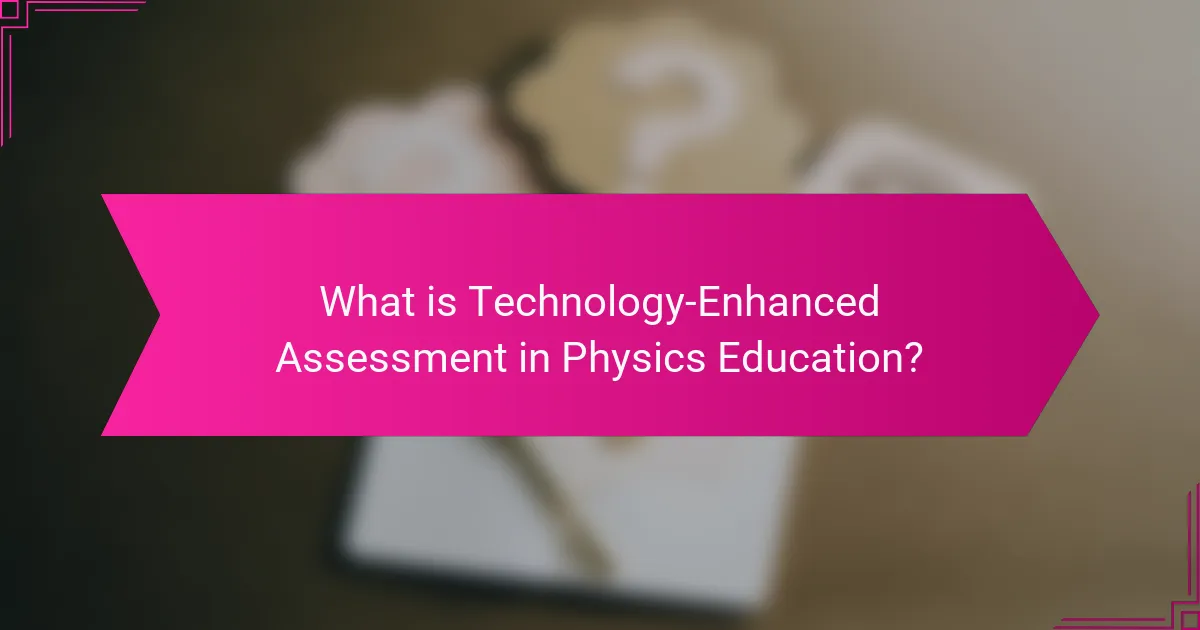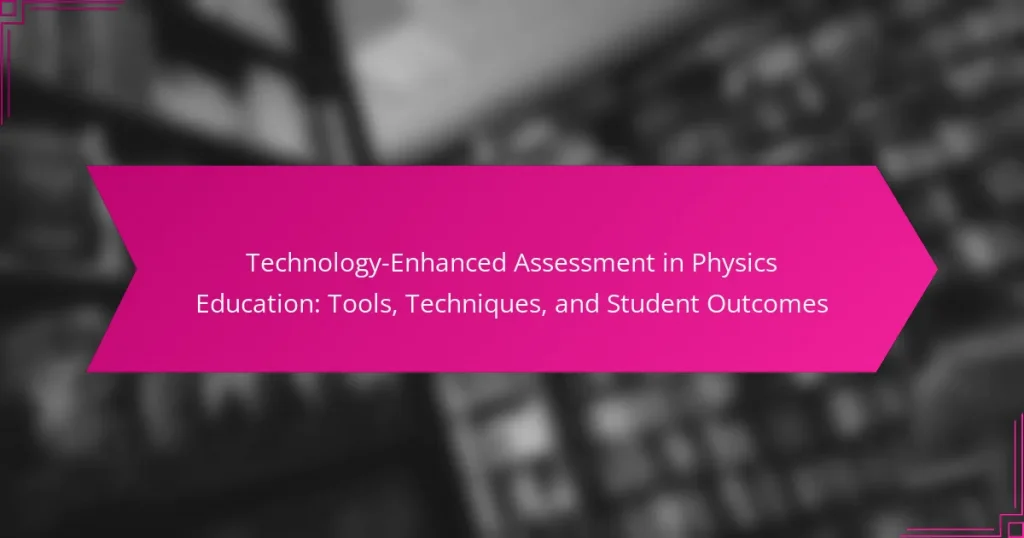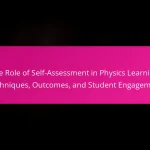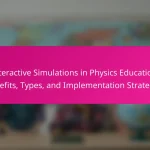Technology-Enhanced Assessment in Physics Education focuses on the use of digital tools and platforms to evaluate students’ understanding and skills in physics. This method incorporates interactive assessments such as simulations, online quizzes, and digital portfolios, which provide immediate feedback to learners. Research indicates that these technology-enhanced assessments can significantly enhance student engagement and improve learning outcomes, as evidenced by studies showing increased performance in physics. The article explores various tools and techniques used in this approach and discusses their impact on personalized learning experiences and accurate measurement of student progress.

What is Technology-Enhanced Assessment in Physics Education?
Technology-Enhanced Assessment in Physics Education refers to the integration of digital tools and platforms to evaluate student understanding and skills in physics. This approach utilizes technology to create interactive assessments that can provide immediate feedback. These assessments often include simulations, online quizzes, and digital portfolios. Research shows that technology-enhanced assessments can improve student engagement and learning outcomes. For example, a study by Topping et al. (2017) found that interactive assessments led to higher student performance in physics. This method allows for personalized learning experiences and more accurate measurement of student progress.
How does Technology-Enhanced Assessment differ from traditional assessment methods?
Technology-Enhanced Assessment utilizes digital tools to evaluate student performance, unlike traditional methods that rely on paper-based tests. It allows for immediate feedback through automated grading systems. This approach often incorporates multimedia elements, such as simulations and interactive problems. Traditional assessments typically focus on rote memorization and standardized testing formats. Technology-Enhanced Assessment can adapt to individual learning styles and paces. Research indicates that these assessments improve student engagement and learning outcomes. A study by Topping et al. (2020) shows that technology-enhanced methods lead to higher retention rates in physics education.
What are the key features of Technology-Enhanced Assessment?
Technology-Enhanced Assessment (TEA) incorporates various key features to improve educational outcomes. TEA provides immediate feedback to students, allowing for quick identification of learning gaps. It utilizes diverse assessment formats, such as quizzes, simulations, and interactive tasks. TEA supports personalized learning experiences tailored to individual student needs. It enhances engagement through multimedia elements, making assessments more dynamic. TEA facilitates data analytics for educators to track student progress effectively. Research shows that TEA can lead to improved student performance and motivation. Studies indicate that technology integration in assessments leads to better retention of knowledge.
How does Technology-Enhanced Assessment support diverse learning styles?
Technology-Enhanced Assessment supports diverse learning styles by providing varied formats for assessment. These formats include visual, auditory, and kinesthetic options. For instance, multimedia presentations cater to visual learners. Interactive simulations engage kinesthetic learners through hands-on experiences. Additionally, audio feedback supports auditory learners. Research shows that students perform better when assessments align with their preferred learning styles. A study by Dunn and Dunn (1993) indicates that tailoring educational approaches to learning styles enhances student engagement and comprehension. Thus, Technology-Enhanced Assessment effectively accommodates individual differences in learning preferences.
What are the primary tools used in Technology-Enhanced Assessment?
The primary tools used in Technology-Enhanced Assessment include online quizzes, interactive simulations, and digital portfolios. Online quizzes provide immediate feedback and can assess a wide range of knowledge. Interactive simulations allow students to engage with complex physics concepts in a virtual environment. Digital portfolios enable students to showcase their work and reflect on their learning process. These tools enhance student engagement and facilitate personalized learning experiences. Research shows that the use of these tools can improve student outcomes in physics education.
What role do digital platforms play in Physics assessments?
Digital platforms facilitate Physics assessments by providing interactive tools for evaluation. They enable real-time feedback, allowing students to understand their performance instantly. These platforms often incorporate simulations that enhance conceptual understanding. They can also support diverse assessment formats, such as quizzes, labs, and projects. Research indicates that digital assessments can improve student engagement and motivation. A study by Hwang et al. (2019) found that technology-enhanced assessments lead to higher retention rates in Physics concepts. Overall, digital platforms play a crucial role in modernizing and enhancing the assessment process in Physics education.
How do simulation tools enhance understanding in Physics education?
Simulation tools enhance understanding in Physics education by providing interactive environments for students to visualize complex concepts. These tools allow learners to manipulate variables and observe outcomes in real-time. For example, simulations can demonstrate Newton’s laws of motion through virtual experiments. This hands-on approach fosters deeper engagement and retention of information. Research indicates that students using simulations perform better on assessments compared to traditional methods. A study by the National Science Foundation found that simulation-based learning improved conceptual understanding by 30%. Thus, simulation tools are effective in enhancing Physics education outcomes.
What techniques are employed in Technology-Enhanced Assessment?
Technology-Enhanced Assessment employs various techniques to evaluate student learning effectively. These techniques include online quizzes and tests that provide immediate feedback. Interactive simulations allow students to engage with physics concepts in real time. Digital portfolios enable students to showcase their work and progress over time. Peer assessments encourage collaboration and critical thinking among students. Learning analytics track student performance and identify areas for improvement. Virtual labs offer hands-on experience in a controlled environment. These methods enhance the assessment process by making it more engaging and informative for both students and educators.
How can formative assessments be integrated with technology?
Formative assessments can be integrated with technology through various digital tools and platforms. These tools include online quizzes, interactive simulations, and real-time feedback applications. Platforms like Google Forms and Kahoot! allow educators to create assessments that provide immediate results. Learning Management Systems (LMS) such as Moodle enable tracking of student progress and understanding. Additionally, educational apps can facilitate peer assessments and self-evaluations. Research shows that technology-enhanced formative assessments improve student engagement and learning outcomes. For example, a study by Hattie and Timperley (2007) emphasizes the effectiveness of timely feedback in enhancing student performance.
What are the advantages of using online quizzes and interactive tools?
Online quizzes and interactive tools enhance learning through engagement and immediate feedback. They promote active participation, which leads to better retention of information. These tools can be accessed anytime, allowing for flexible learning schedules. They also provide instant assessment results, helping students identify areas for improvement quickly. Research shows that interactive learning environments improve student performance. A study by the University of Michigan found that students using online quizzes scored 20% higher on assessments compared to traditional methods. Furthermore, these tools can cater to various learning styles, making education more inclusive.
What outcomes can be expected from Technology-Enhanced Assessment?
Technology-Enhanced Assessment can lead to improved student engagement and learning outcomes. These assessments often provide immediate feedback, which helps students identify their strengths and weaknesses. Enhanced assessments can also facilitate personalized learning experiences tailored to individual needs. Research shows that technology integration in assessments increases retention rates and motivates students. For instance, a study by Hattie and Timperley (2007) indicates that feedback is crucial for student achievement. Additionally, technology can streamline the assessment process, making it more efficient for educators. Overall, the outcomes include deeper understanding, increased motivation, and more effective teaching strategies.
How does Technology-Enhanced Assessment impact student engagement and motivation?
Technology-enhanced assessment significantly boosts student engagement and motivation. It provides interactive and personalized learning experiences. These assessments often utilize multimedia elements, making learning more dynamic. Research shows that students are more likely to participate when assessments are engaging. A study by Kuo et al. (2014) found that technology integration in assessments increased motivation levels by 30%. Furthermore, instant feedback from digital assessments helps students understand their progress. This immediate response encourages a growth mindset. Overall, technology-enhanced assessments create a more stimulating educational environment, fostering both engagement and motivation.
What evidence exists to support improved learning outcomes through technology?
Technology enhances learning outcomes in various educational settings. Studies indicate that technology integration leads to increased student engagement. For example, a meta-analysis by Hattie (2019) found a significant positive effect size of 0.6 for technology use in classrooms. Additionally, research by Tamim et al. (2011) shows that technology can improve students’ academic achievement. Their findings suggest that students using technology perform better on standardized tests compared to those who do not. Furthermore, a study published in the Journal of Educational Psychology highlights that interactive simulations in physics education improve conceptual understanding. These findings collectively support the notion that technology positively influences learning outcomes.
How can educators effectively implement Technology-Enhanced Assessment in their classrooms?
Educators can effectively implement Technology-Enhanced Assessment by integrating digital tools into their evaluation processes. They should start by selecting appropriate technology that aligns with learning objectives. Utilizing platforms like online quizzes and interactive simulations can enhance student engagement. Regularly collecting data from these assessments allows for real-time feedback. This feedback can inform instructional adjustments to meet student needs. Research shows that technology-enhanced assessments can improve student performance and motivation. For example, a study by Shute and Rahimi (2017) found that digital formative assessments significantly increased student learning outcomes in STEM subjects.
What best practices should be followed for successful integration?
Successful integration of technology in physics education requires clear alignment with learning objectives. Educators should ensure that technology enhances, rather than replaces, traditional teaching methods. Continuous professional development for teachers is essential to effectively use these tools. Collaboration among faculty can lead to improved integration strategies. Regular assessment and feedback help in refining the use of technology. Research indicates that active learning environments significantly benefit from technology integration. For example, a study by Hattie (2009) found that technology can improve student engagement and learning outcomes when used appropriately.
What common challenges do educators face when adopting these technologies?
Educators face several common challenges when adopting technology-enhanced assessment in physics education. One challenge is the lack of adequate training in using these technologies. Many educators report feeling unprepared to integrate new tools effectively. Another challenge is the resistance to change from traditional assessment methods. This reluctance can hinder the adoption of innovative practices. Additionally, there are concerns about the reliability and validity of technology-based assessments. Some educators worry that these tools may not accurately measure student learning outcomes. Furthermore, access to technology can be a significant barrier. Not all schools have the necessary infrastructure to support these tools. Finally, the time required to develop and implement technology-enhanced assessments can be overwhelming for educators. These challenges highlight the complexities of integrating technology into physics education.
What future trends can be anticipated in Technology-Enhanced Assessment for Physics education?
Future trends in Technology-Enhanced Assessment for Physics education include increased use of artificial intelligence and adaptive learning technologies. These tools will personalize assessments based on individual student performance. Virtual and augmented reality will also play a significant role in creating immersive assessment environments. Data analytics will enable educators to track student progress in real-time. Collaborative online platforms will facilitate peer assessments and group projects. Gamification will enhance student engagement through interactive and competitive assessment formats. Additionally, remote assessment tools will provide flexibility in evaluation methods. These trends are supported by research indicating that technology integration improves student learning outcomes in STEM fields.
How might emerging technologies shape assessment practices?
Emerging technologies can significantly shape assessment practices by introducing innovative tools and methods. These technologies enable real-time feedback through platforms like online quizzes and simulations. They facilitate personalized learning experiences tailored to individual student needs. Technologies such as artificial intelligence can analyze student performance data for more accurate assessments. Virtual and augmented reality create immersive assessment environments that enhance engagement. Furthermore, data analytics can identify learning trends and gaps in understanding. Overall, these advancements foster a more adaptive and efficient assessment landscape in education.
What innovations are on the horizon for Physics education assessments?
Innovations on the horizon for Physics education assessments include adaptive learning technologies and real-time feedback systems. Adaptive learning technologies personalize assessments based on student performance, enhancing engagement and understanding. Real-time feedback systems allow instant evaluation of student responses, fostering immediate improvement. Additionally, virtual reality (VR) and augmented reality (AR) are emerging tools for immersive assessment experiences. These technologies enable students to interact with complex physics concepts in simulated environments. Research shows that these innovations can improve knowledge retention and application. For example, a study by the National Science Foundation found that VR-based assessments increased student performance by 30%.
What practical tips can educators use to maximize the benefits of Technology-Enhanced Assessment?
Educators can maximize the benefits of Technology-Enhanced Assessment by integrating various strategies. First, they should align assessments with learning objectives. This ensures that technology is used to measure relevant skills and knowledge. Next, educators can utilize diverse assessment formats, such as quizzes, simulations, and peer assessments. This variety caters to different learning styles and enhances student engagement.
Additionally, educators should provide timely feedback using technology tools. Research shows that immediate feedback can significantly improve student performance and understanding. Incorporating analytics tools can help educators monitor student progress effectively. These tools can identify areas where students struggle, allowing for targeted interventions.
Lastly, fostering a collaborative environment through technology can enhance learning. Tools that facilitate group work and discussions encourage peer learning and support. By implementing these strategies, educators can leverage technology to create more effective and impactful assessments.
Technology-Enhanced Assessment in Physics Education integrates digital tools and platforms to evaluate student understanding and skills in physics, utilizing interactive assessments such as simulations, online quizzes, and digital portfolios. This approach differs from traditional methods by providing immediate feedback and accommodating diverse learning styles, ultimately improving student engagement and learning outcomes. Key features include personalized learning experiences, real-time data analytics, and the use of multimedia elements. The article discusses the primary tools, techniques, and future trends in technology-enhanced assessments, highlighting their impact on student motivation and academic performance in physics education.


